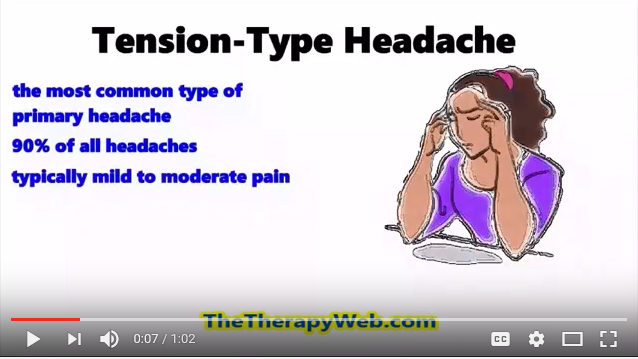Tension Headaches
Original Editors - Students from Bellarmine University's Pathophysiology of Complex Patient Problems project.
Top Contributors - Grite Apanaviciute, Simisola Ajeyalemi, Jacquelyn Brockman, Vidya Acharya, Elaine Lonnemann, Eugenie Lamprecht and WikiSysop
Definition/Description[edit | edit source]
Tension-type headaches (TTH) are the most common type benign headache. They can affect all aspects of one’s life including work, school, and home life (1). TTH may result in disability, missed workdays, and decreased quality of life (2). They are characterized by how often an individual experience them in a given month. If an individual experiences tension-type headaches 14 or less days out of a month then it is considered episodic. If they experience these headaches 15 or more days out of a month for 3 consecutive months, then they are considered to be chronic. The etiology behind these headaches is still unknown. It is believed that changes in levels of neurotransmitters may be a contributing factor.
[[Mediahttps://www.youtube.com/watch?v=153URODVbds&app=desktop
Prevalence[edit | edit source]
Episodic tension type headaches (TTH) are the most prevalent type of headache. Research has found that approximately 38% of individual’s experience TTHs in a given year (1,2,3). In Denmark, it was found that 78% of the population experienced TTHs at some point in their lifetime (4). Approximately 24% to 37% of individual’s experience TTHs multiple times a month (4). According to Schwartz study in 1998, women are more likely to experience TTHs in every race, age group, and educational level. Tension-type headaches usually begin in an individual’s teenage years, and those between the age of 30 and 39 are at the highest risk (1). Schwartz found that 40.1% of Caucasian men and 46.8% of Caucasian women experienced TTHs in a single year. In the African American population, the prevalence of TTHs in a year was 22.8% in men and 30.9% in women. There is a positive correlation between educational levels and prevalence of TTHs with graduate students being most at risk.
Characteristics/Clinical Presentation[edit | edit source]
There are two types of tension-type headaches: episodic and chronic. Episodic TTHs are characterized by occurring less than 15 days out of a month5. They can last anywhere from a few hours to several days. Patients usually report feeling symptoms such as a tight band or pressure around their head and/or neck. These headaches are most often bilateral but can be unilateral. They range from mild to moderate in intensity and do not have any of the associated symptoms which are found in migraines.
TTHs are characterized as chronic when their symptoms persist for 15 or more days within a month for three consecutive months. Because of the moderate to severe intensity of chronic TTHs, this type of headache is more debilitating than the episodic TTHs. In addition to feeling pressure around the head and/or neck, patients with chronic TTHs may experience mild nausea.
Associated Co-morbidities[edit | edit source]
1. Generalized anxiety disorder 6,7 2. Major depression disorder 6,7,8 3. Suicidal ideation 9 4. Impairment in quality of life and functional abilities 8 5. Dementia 10
Medications[edit | edit source]
add text here
Diagnostic Tests/Lab Tests/Lab Values[edit | edit source]
add text here
Etiology/Causes[edit | edit source]
add text here
Systemic Involvement[edit | edit source]
add text here
Medical Management (current best evidence)[edit | edit source]
add text here
Physical Therapy Management (current best evidence)[edit | edit source]
add text here
Differential Diagnosis[edit | edit source]
add text here
Case Reports/ Case Studies[edit | edit source]
add links to case studies here (case studies should be added on new pages using the case study template)
Resources
[edit | edit source]
add appropriate resources here
Recent Related Research (from Pubmed)[edit | edit source]
see tutorial on Adding PubMed Feed
Extension:RSS -- Error: Not a valid URL: addfeedhere|charset=UTF-8|short|max=10
References[edit | edit source]
see adding references tutorial.







